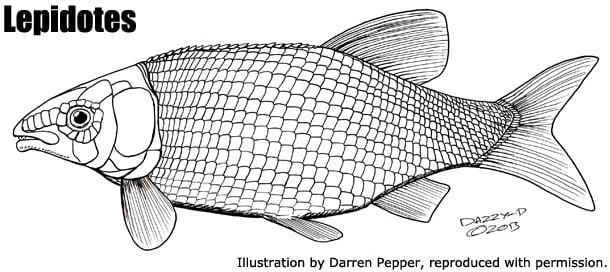In Depth
For all intents and purposes Lepidotes was like a Mesozoic carp that was very common in the old world waterways of Eurasia as well as North Africa. Like todays carp Lepidotes was a suction feeder that sucked morsels of food and small prey into its mouth, something it was able to do because its upper jaw was no longer connected to the jugal bone like in many other earlier fish. This allowed Lepidotes to suck in prey from a small distance away rather than have to make contact and close its mouth around it. The densely packed peg-like teeth inside the mouth would have been suitable for crushing the shells of molluscs such as aquatic snails, but Lepidotes probably would have also eaten other hard bodied invertebrates such as the larvae of flying insects.
The abundant numbers of Lepidotes in the fossil record as well as its broad geographical range mean that Lepidotes would have formed an important part of an ecosystems biomass, particularly as a prey species of predatory animals. The most famous example of predator prey interaction for Lepidotes is the partially digested remains that were found in what would have been the stomach of the spinosaurid dinosaur Baryonyx that was first discovered in England.
Further Reading
– Notices of remains of extinct reptiles and fishes, discovered by Dr. F. V. Hayden in the bad lands of the Judith River, Nebraska Territory. – J. Leidy – 1856. – Some new specimens of the fossil fish Lepidotes from the English Upper Jurassic. – S. L. Jain & P. L. Robinson – 1963. – Lepidotes gloriae, sp. nov. (Actinopterygii: Semionotiformes) from the Late Jurassic of Cuba. – D. Thies – 1989. – Early Cretaceous freshwater fish fauna in Kyushu, Japan. – Y. Yabumoto – 1994. – Les Lepidotes (Actinopterygii, Semionotiformes) de Cretace inferieur (Barremien) de Las Hoyas (Province de Cuenca, Espagne). – S. Wenz – 2003. – A new species of Lepidotes (Neopterygii: Semionotiformes: Semionotidae) from the Santana Formation, Lower Cretaceous of Northeastern Brazil. – P. M. Brito & V. Gallo – 2003.










